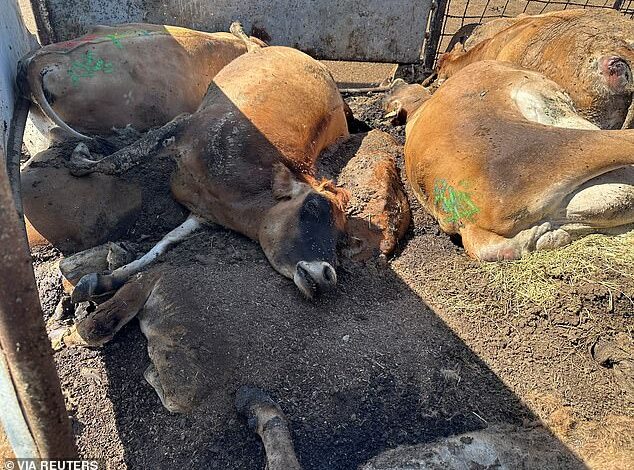CDC warns of outbreak of ‘cow flu’ in several Americans


The H5N1 bird flu virus spreading among cows is infecting more farm workers than experts realized.
The CDC tested 115 workers at farms experiencing outbreaks and found eight of them tested positive for the virus — an infection rate of 7 percent.
Many of them had no symptoms, which officials said indicates that H5N1 is spreading much more widely than official figures indicate.
Forty-six farm workers have been officially diagnosed with the virus, but hundreds of livestock farms in dozens of states are experiencing outbreaks.
The CDC now recommends that anyone exposed to infected animals get tested, not just those who become sick.
The agency said it sees no mutations in the virus that would lead to easier transmission or evidence of person-to-person spread.
But disease experts have warned that as the virus circulates, the chance of evolution increases, which could lead to a pandemic.
A pig on an Oregon farm tested positive for H5N1 for the first time in the US last week, raising alarm because pandemic pigs have been a source of previous human pandemics.

Dead cows are piling up in California as dairy farmers battle the H5N1 bird flu, which made landfall in the state in August
The CDC’s change in testing guidelines comes after a study of 115 farmworkers in Michigan and Colorado who were exposed to H5N1.
Of the eight employees with positive blood tests, four reported no symptoms.
All eight cleaned the parlors and none used respiratory protection such as face masks. Three said they used eye protection.
High levels of the virus have been found in the milk of infected cows, increasing the risk of exposure and infection, the researchers said.
The United States Department of Agriculture (USDA) has said it will begin testing bulk milk for bird flu. This indicates that both agencies are concerned about the continued spread of the virus on dairy and poultry farms.
The CDC also recommends offering the antiviral drug Tamiflu to workers at high risk of exposure to sick animals and expanding guidelines for protective equipment for workers, including eye protection.
Agency researchers said efforts to monitor dairy workers for disease are hampered by several barriers, including the reluctance of farm owners and farm workers to allow testing.
Bird flu has infected nearly 450 dairy farms in 15 states since March, according to USDA data.
Nirav Shah, CDC’s principal deputy director, said, “The goal of these actions is to keep workers safe, limit transmission of H5 to humans, and reduce the possibility of the virus changing.”
Outside experts said it’s notable that the investigation prompted the CDC to take new action.
“This is an important step toward assessing that these H5N1 viruses pose a greater risk than the CDC previously estimated,” said Dr. Gregory Gray, an infectious disease researcher at the University of Texas Medical Branch in Galveston.
Each additional infection in animals or humans gives the virus an opportunity to change in potentially dangerous ways, says Angela Rasmussen, a virus expert at the University of Saskatchewan in Canada.
“It shows once again that we are not responding effectively to the H5N1 outbreak in humans and animals, and if we continue to spread this virus and jump from species to species, our luck will eventually run out,” Rasmussen said.
Rasmussen and others have criticized the federal response to the outbreak as too slow and “lackluster.”
“These investigations should have been conducted months ago and should have been prioritized,” she said.




